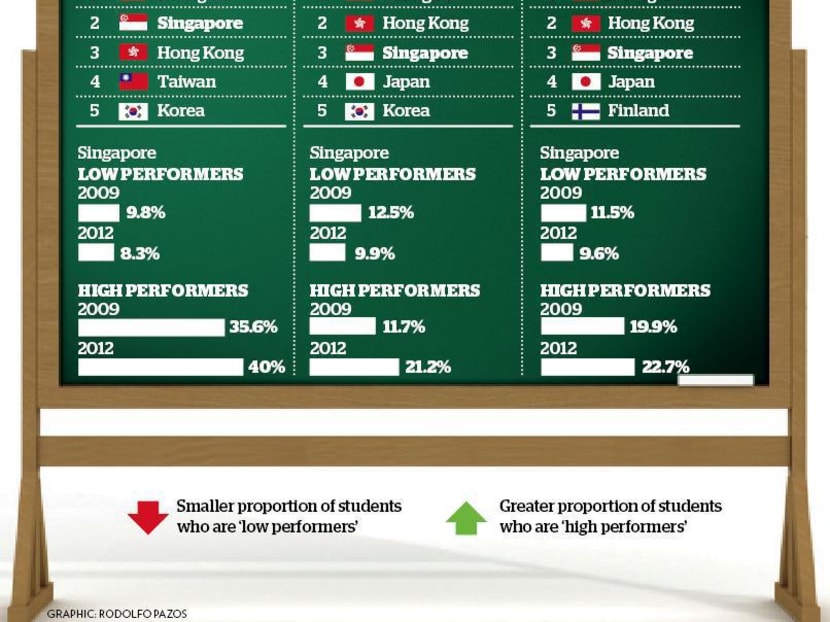S’pore students closer to top of table in PISA test
SINGAPORE — The Republic has improved on its first strong showing and again emerged among the top performers in what has been dubbed the most influential international scorecard for education systems around the world.
SINGAPORE — The Republic has improved on its first strong showing and again emerged among the top performers in what has been dubbed the most influential international scorecard for education systems around the world.
The results of the latest triennial Programme for International Student Assessment (PISA) test, organised by the Organisation for Economic Cooperation and Development (OECD), was released yesterday.
The test, which was conducted last year in 65 participating cities and territories, assessed 15-year-olds’ mathematics, science and reading literacy skills. Singapore students came in second in mathematics and third in both reading and science.
In 2009, the Republic participated in the PISA test for the first time. Then, its students were ranked second in mathematics, fourth in science and fifth in reading.
Shanghai came in first in all three subjects for the second consecutive time. The latest test results show East Asian cities and territories dominating the top positions, with traditional education powerhouse Finland falling in ranking.
Commenting on the overall performance by the Republic’s students, Singapore’s Ministry of Education (MOE) noted that both academically weaker and stronger pupils did better, compared with the batch who took the previous test in 2009.
The PISA test was conducted in Singapore between April and May last year. A total of 5,369 students — mainly from Secondary 3 and 4 — participated. Most of them were from the 166 public secondary schools here, while 177 students from six private schools — including madrasahs and schools with foreign systems — also took the test. Apart from written and computer-based assessments, students and principals had to fill in questionnaires that covered topics such as learning experience and environment.
Noting that Singapore was also one of the top performers among the 32 education systems which participated in the computer-based assessments of mathematics and reading, the MOE cited other key findings from the PISA report: The strong performance of pupils in Singapore across the different areas of assessment “shows that most of our students were adept at applying their knowledge and skills in novel ways”. There was also a high level of motivation in learning mathematics, said the ministry.
MOE ON ‘RIGHT TRACK’
Ms Ho Peng, Director-General of Education, said the findings showed the MOE is “on the right track”. “The findings are heartening in showing how we have levelled up our academically weaker students and given them a strong foundation,” she added.
The MOE attributed the progress made by academically weaker students to their schools’ continuous effort and dedication in supporting them, as well as the improvement in teaching methods to meet their learning needs.
A “systematic effort” is taken to provide more customised support for weaker learners in mathematics and science in primary and secondary schools. For example, some schools are deploying more teachers for the Normal (Technical) course to monitor and support students.
Understanding the learning profiles of such students have led to the provision of more targeted resources and support for this group, said the MOE.
Ms Adeline Chan, Senior Specialist for English Language (Secondary), Curriculum Planning and Development Division (CPDD), said that, under the new English syllabus implemented in 2010, students are more exposed to content such as infographics, advertisements and brochures, which are used in the PISA test. Among other skills, students in Singapore are taught to “discern the validity of a writer’s source and whether or not it is suspect”, she said.
Mrs Cynthia Seto, a Master Teacher in mathematics, noted that students are more engaged in the learning process through various IT tools and strategies. “Students make conjectures (and) connections, test their assumptions and construct a logical argument about what they see,” she said.
An MOE spokesperson reiterated that “achieving a good global ranking in PISA is not the reason we participated in the studies”.
“Rather, we see it as a useful tool that provides us with objective, internationally comparable information about the progress of our students and their preparedness to meet the challenges of life in the 21st century,” she said. “We will continue to focus on working with our schools to achieve the desired outcomes of education, which are beyond what is measured in PISA, to encompass the holistic development of our students.”
MOE Deputy Director-General of Education Loh Khah Gek noted the limitations of the PISA test. “There may be specific skills and competencies that cannot be tested in this way, like cross-cultural understanding (and) the ability to connect with people (and) collaborate with others,” she said.







